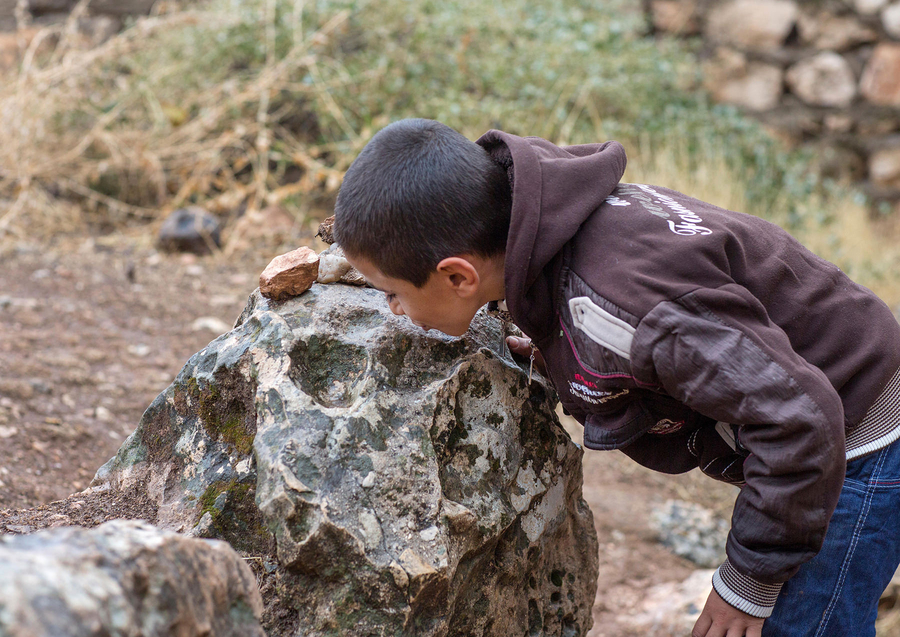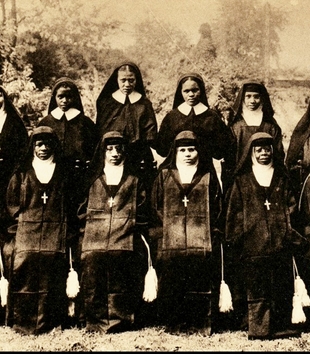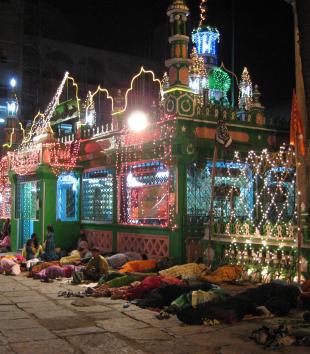Anna Bigelow (AB): Thank you Christy for agreeing to talk with us for this special issue of MAVCOR Journal on “Material Islam.” We thought to start by asking you, as a scholar who has watched this field change and grow, and as someone who works at the intersection between Islamic studies and art history, and religious studies and materiality studies in general: how would you characterize the growth of this field and how has it changed?
Christiane Gruber (CG): I would say that just like every field, “Material Islam” is now branching out in various directions. Materiality is interesting for scholars from multiple disciplines, and not just the humanities. Every expert—from art historians to cultural historians and anthropological archaeologists—brings a different skill set and methodological apparatus to a question or a corpus of objects. To a certain degree, I don’t feel the need to erect particular disciplinary boundaries for the trends we see unfolding.
This said, I do see a few different trajectories and they're all productively co-constitutive. One line that is emerging from Material Culture is a closer attention to popular culture. The forthcoming Bloomsbury Handbook on Muslims and Popular Culture edited by Kristian Petersen and Hussein Rashid (2023) will be an important contribution to the field, especially since its essays focus on Islamic material cultures at the sub-elite level. These studies will further break down hierarchies and categories—such as fine art vs. artifacts—that have a long-lasting history and implications for objects that have been deemed “worthy” of study.
Another interesting development is a growing concern with non-humanmade matter. In the past few years we’ve witnessed an ecological turn in the humanities, which will only accelerate. The environmental or ecological humanities, as an inter-discipline, will expand the study of both materiality and Islam. So, I anticipate seeing more attention paid to the so-called green dīn [faith] of Islam and the rise of the green Muslim movement. Anna Gade has studied this issue thoroughly in her 2019 book Muslim Environmentalisms.1 She’s opened the door to the subject, extending an invitation for future research. For my purposes, that means rethinking the canon of Islamic religious art and architecture. For example: what if we were to think of the Ka‘ba primarily as an architectural reliquary for the black stone (al-ḥajar al-aswad)? How would that change our view of Islam’s holiest structure? And what if we thought about the Zamzam well in Mecca as a water reliquary, the Prophet’s mosque in Medina as a structure housing sacred soil and the miraculous palm tree, his tomb as emitting primordial light, itself a creative substance of sorts? And then there’s the Dome of the Rock (qubbat al-ṣakhra), whose name reveals its status as a sanctum that houses a lapidary contact-relic of Muhammad’s footprint. These three examples—all canonical but pointing to so many other cases, especially modern and within minority communities—suggest that the ecological turn will force us to “see” things, people, and vibrant matter (to borrow Jane Bennett’s expression) differently within material Islamic studies.2
Concurrently we also must take into serious consideration emic Islamic textual and oral traditions, especially how Muslim philosophers have developed their own eco- and material philosophies over the centuries. The repository is indeed there, so it's just a question of digging in and connecting the dots. The time is right, and I foresee some interesting interventions. Among others, a forthcoming issue of [the journal] Material Religion, edited by Hala Auji and Elizabeth Rauh, is entitled Manufacturing the Sacred: Objects of Veneration in the Modern Islamic World. This volume will explore religious devotional arts, including mass-produced devotional posters, printed miniature Qur’ans, and more—items that scholars have tended to marginalize for various reasons. This publication also tackles mechanical means of production, like the printing press and reprographic arts; it thus will further expand the field of technological materialism as well.
I should also mention that the Hamad Bin Khalifa Symposium, a three-day event in fall 2021, was dedicated to ecology and the environment in Islamic art and culture. The papers will likely be published in a volume dedicated to the subject, so this conference will prove a major turning point for Islamic art history in particular. A stand-out paper was the keynote lecture delivered by Nasser Rabbat, in which he explored the notion of delight (al-bahja) in the Qur’an, as an emic pivot to understand the material (especially thermal) qualities of Islamic architecture. As a result, the basic concepts of joy and happiness can be given gradations of meaning via indigenous thought cultures and their material manifestations.
Kambiz GhaneaBassiri (KGB): I wanted to ask something more practical about the challenges associated with a field branching out in different directions. Today, the American Academy of Religion, for example, serves as a professional home to a variety of scholars, from those working on graphic arts to those working on Kierkegaard, to people working on Muslim pilgrimages. It can be dizzying sometimes. How do you train younger scholars for a field that is amorphous? What recommendations do you have for younger scholars for managing the speciation that you see in the study of materiality in Islam?
CG: Yes, that is always the issue: managing too much variety or “TMI,” or “too much information.” It's not easy to keep up with trends and developments, so I think it's important to understand the root of your own selected discipline(s) and to find a scholarly equilibrium for yourself. Because we operate in different fields that have their own trajectories, we have to be explicitly aware of our intellectual heritages, which we can criticize, nuance, and expand as we see fit. For Islamic art history, it's important to read the work of Oleg Grabar and other major thinkers. But if you're going to branch out into material culture and write about, say, ablution socks and other devotional paraphernalia, then you might not find those works [by Grabar et al.] terribly useful methodologically speaking. That’s where you have to start navigating some cognate disciplines, such as popular culture, visual and material culture, sartorial traditions, religious studies, cultural studies, and so on. In this and other cases, one has to be open but also selective, to expand one’s own horizons while also ensuring a logical intellectual bracketing. You have to know how to branch out—and then reign it in. This moving equilibrium can be a bit dizzying for the younger generation as they wind their way through academia today. But at the same time, if a scholar were to write an article on, e.g. Islamic ablution socks, they can now place it in the Journal of Material Cultures in the Muslim World, which was launched very recently (in 2020). This type of study is not the “main fare” of other journals of Islamic art, like Muqarnas. In other words, intellectual maturation pries open new venues for publication, which in turn support successful trajectories towards tenure, the latter securing professorial lines. This cause-and-effect model has a tendrillar effect, restructuring the academy over time.
AB: The more one reads in these spheres the more you start to see this percolating language that permeates everybody's discourses. It's like we're all Deleuzian now . . . everybody is talking about assemblages and that has become a kind of touchstone. There are often gestures towards vital matter and Bennett's work, or Latour’s actor-network theory, or object-oriented ontologies. These appear in fragmentary ways everywhere. But they also help to create a little bit of a conversational structure. Like Michael Knight's new book on the Prophet's body and baraka networks; it's very much thought through Deleuzian frames, but he's also working with hadith literature.3 It’s exciting to see how one can bring a theoretical apparatus that crosscuts disciplines and then finds a home within an Islamic studies framework. Could somebody who's just reading about Deleuze have access to something like what Knight is doing in that book? I guess that circles back to a question that Kambiz often asks: are there tensions or productive opportunities in engaging concepts of materiality from Islamic studies with other approaches to material religion? For example, you were just gesturing to ideas of al-bahja (delight) being one frame that people would have access to from different perspectives in Islamic studies, whatever their training, philological, or ethnographic, or art historical, that might also be meaningful to scholars outside of Islam.
CG: Absolutely. I think it takes a while to get that overarching framework established, and it takes many minds to pull together a skeletal thought structure from within the Islamic tradition. But it's certainly underway. For example, Doris Behrens-Abouseif has written a book on the notion of beauty in Arabic/Islamic culture, as has Valérie Gonzalez.4 My colleague Bilal Badat is now leading an international project exploring beauty and Islamic theology. These and future efforts will help us craft a larger analytical vocabulary rooted in Islamic traditions, without willy-nilly inserting our objects of study into a “pre-fabricated” Deleuzian assemblage.
In the meantime, it seems like you were saying, Anna, that for those of us who are interested in vibrant matter, new materialisms, etc., then the way that we can connect theoretically is by referring to the same corpus of thinkers: Guattari, Deleuze, Bennett, Coole, Frost, and so forth. If we can engage with the work of these scholars, then great. However, most of this scholarship is Euro-American, not only in terms of the scholars, but also the objects of their study. This gives me some concern for those of us working within Islamic studies. Why? Well, traditionally to have a seat at the table, a scholar of Islamic studies has had to deploy the same theo-lingo (theoretical language) as Europeanists and Americanists. But what if we flipped the proverbial table and asked our colleagues conversant in Derrida and Bourdieu to seriously take up al-Ghazali and al-Farabi in their scholarship instead? Some might find this proposal ludicrous… and that would reveal, to a certain degree, the obscenity of expectations that flow the other way. And yet bilateral engagement is needed if we, as Islamicists, don't want to remain “asterisk” scholars: that is, small punctuation points operating below larger conversations.
AB: Something that we thought would be exciting about trying to do something with a venue like MAVCOR was that we can do more galleries. We can have interviews. We can use as many images as we want. We can experiment with using the original scripts, and have it in the text, and have it be visible, so people can search it. And also explore the emic vocabularies around materiality that are coming from various Islamic worlds. So I feel like there are some interesting affordances in this kind of a venue that would ideally also help us to perhaps think differently. Not just new ways to present, but to have intellectually productive qualities as well. If we can actually imagine scholarship in new ways, maybe this deepens, or expands, or extends the ways in which we can consider, not just the form of publication, but what we can even conceptualize?
CG: I completely agree. Let’s think of one tiny example that forces a shift of conceptualization: Right now, we’re thinking, talking, and writing in English, so we’re operating in an Anglophone linguistic orbit. But, for the sake of hypothesis, if we were communicating in the Persian, Turkish, or Kurdish tradition right now, we’d be using a third person pronoun (u/o/ew) that is neither gender-differentiated nor animacy-determinant, especially, for Kurdish, in the nominative case. That is, no division between “he,” “she,” and “it”—a phenomenon observable in other world languages, as noted by Amia Srinivasan.5 Basic pronouns hardwire the brain grammatically, but what if we re-wired our thought processes so that, say, I, a scholar often identified as a human female, can be a Persian, Turkish, and Kurdish “it” on linguistic parr with the singing nightingale (bulbul) of Persian poetry or the wild walnut tree (zergûz) sacred to the Yezidis? Could the “it” linguistic move allow me to confront, perhaps labor to overcome, my own anthropocentric supremacy, to cede to animals and nature their own centrality and agency without resorting to a wholesale adoption of posthumanistic thought, itself still heavily Euro-American in its praxis and parameters? These are the kinds of productively self-critical and agitational “moves” that I think can restructure not just the mind, but the humanities, too.
KGB: Tell us about some of your exciting and recent new works, and others looming on the horizon.
CG: I'm on sabbatical this academic year (2022-23) after three years of serving as a departmental chair. I am relishing a return to field research and writing while based in Turkey. My plan is to gather further materials to write my next book, tentatively entitled Elements of the Middle East: Art, Ecology, and Faith. This project on eco-Islamic art and architecture will rethink the canon through environmental frameworks (including emic ones) and expand it to include modern materialities and minority communities, including the Alevis, Naqshbandis, Berbers, and Yezidis, among others. My travels this year will see me visit painted mosques of rural Anatolia (Fig. 1) and the eastern Black Sea coast, the dovecotes of Cappadocia (Fig. 2), the sacred sites of Iraqi Kurdistan such as the Yezidi sacred shrine complex in the Valley of Lalish, which includes sacred stones, trees, and olive oil (Fig. 3), and Morocco, where Amazigh earthen architecture, mosques outfitted with solar panels, and the solar field of Ouarzazate have captured my attention.
- 1Anna M. Gade, Muslim Environmentalisms: Religious and Social Foundations (New York: Columbia University Press, 2019).
- 2Jane Bennett, Vibrant Matter: A Political Ecology of Things (Durham: Duke University Press, 2010).
- 3Michael Knight, Muhammad’s Body: Baraka Networks and the Prophetic Assemblage (Chapel Hill: University of North Carolina Press, 2020).
- 4Doris Behrens-Abouseif, Beauty in Arabic Culture (Princeton: Marcus Weiner Publishers, 1999); Valérie Gonzalez, Beauty and Islam: Aesthetics in Islamic Art and Architecture (London, New York: I. B. Tauris, 2001).
- 5Amia Srinivasan, “He, She, One, They, Ho, Hus, Hum, Ita,” London Review of Books 42, no. 13 (2020).
Unrelatedly but concurrently, I am working on the visual culture of the Nation of Islam (NOI). I taught in the Mercer County Jail when I was an undergraduate student at Princeton; at that time, I witnessed and became interested in the process of conversion to Islam through a Nation of Islam chaplain. To date, I've worked my way through Muhammad Speaks, the official NOI newspaper, and have visited Mosque Maryam and NOI Headquarters in Chicago. Muhammad Speaks includes hundreds of visuals that depict an Islamic worldview within an American context: namely, the civil rights movement and Black empowerment of the 1960s and 70s. I plan to write an article on the subject, thus expanding the study of Muslim minority communities and their expressive traditions, in this case within the United States. I’m personally excited to see the expansion of the study of the visual and material culture of Black or African-American Islam, a field that is now experiencing a growth through conferences, publications (such as journal The Muslim World’s July 2020 volume dedicated to Black Muslim portraiture in the modern Atlantic), and the establishment of African-American and/or Islamic museums in America.
In the end, the intersections between Islamic studies, material culture, the ecological humanities, and critical race studies promise to break new and promising ground—and here, too, future scholars will have to toggle thoughtfully between their respective disciplines of training and the new arenas of inquiry that they wish to create via intellectual synergies premised on a bilateral exchange of ideas, including emic ones.
Notes
Keywords
Imprint
10.22332/mav.int.2022.1
1. Anna Bigelow and Kambiz GhaneaBassiri, "In Conversation with Christiane Gruber on Material Islamic Studies," Interview, MAVCOR Journal 6, no. 2 (2022), doi: 10.22332/mav.int.2022.1.
Bigelow, Anna and Kambiz GhaneaBassiri. "In Conversation with Christiane Gruber on Material Islamic Studies." Interview. MAVCOR Journal 6, no. 2 (2022), doi: 10.22332/mav.int.2022.1.





